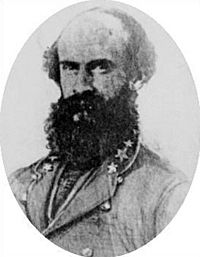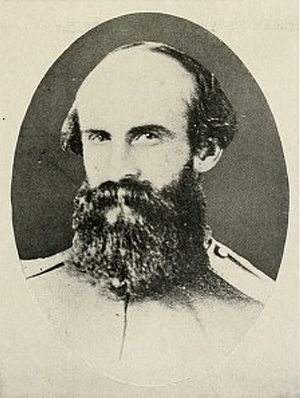William E. Jones (general) facts for kids
Quick facts for kids
William E. Jones
|
|
|---|---|

William "Grumble" Jones
|
|
| Birth name | William Edmondson Jones |
| Nickname(s) | Grumble Jones |
| Born | May 9, 1824 Washington County, Virginia |
| Died | June 5, 1864 (aged 40) Piedmont, Augusta County, Virginia |
| Buried |
Old Glade Spring Presbyterian Church, Glade Spring, Virginia
|
| Allegiance | |
| Service/ |
|
| Years of service | 1848–1857 (USA) 1861–1864 (CSA) |
| Rank | Brigadier General |
| Commands held | |
| Battles/wars | American Civil War |
| Spouse(s) | Eliza Margaret Dunn |
William Edmondson "Grumble" Jones (born May 9, 1824 – died June 5, 1864) was a Confederate cavalry general during the American Civil War. He was known for being very strict with his soldiers. He also often argued with his commanders. However, many people agreed he was a good leader in battle.
Jones had personal disagreements with General J.E.B. Stuart. Because of this, Jones's cavalry unit was assigned to guard supply lines. This meant they were not available during a very important time in the Gettysburg Campaign. During this campaign, General Robert E. Lee needed good cavalry to scout the enemy. The arguments between Jones and Stuart grew worse. Jones even faced charges for being disrespectful. He was then moved to a different command to separate him from Stuart. Jones was killed while leading a counter-attack in the Battle of Piedmont in 1864.
Contents
Early Life and Military Start
William E. Jones was born in Washington County, Virginia. He went to Emory and Henry College in Virginia. After that, he graduated from the United States Military Academy in 1848. He was ranked twelfth in his class. He became a second lieutenant in the U.S. Mounted Rifles.
Jones served with the cavalry, fighting against Native Americans in the western parts of the country. He was promoted to first lieutenant in 1854. His nickname, "Grumble," came from his often grumpy mood. In 1852, his wife drowned in a shipwreck shortly after they got married. They were on their way to Texas. Jones left the army in 1857 and became a farmer near Glade Spring, Virginia.
Joining the Civil War
When the Civil War began, Jones joined the 1st Virginia Cavalry Regiment. He was a captain and led a company of soldiers he had gathered. In May, he was promoted to major in Virginia's army. Later that month, Jones and his regiment joined the Confederate Army.
Jones served under Colonel J.E.B. Stuart at the First Battle of Bull Run in July 1861. The next month, he became a colonel and took command of the 1st Virginia Cavalry. Jones was a regular army officer. He made his new volunteer soldiers train very carefully. He would scold anyone who was slow to learn the drills.
In the fall of 1861, the Confederate forces changed their organization. Soldiers could vote for their officers. Jones was not re-elected to lead the 1st Virginia Cavalry. In September, he was given command of the 7th Virginia Cavalry. He led this regiment into Western Virginia, along the Potomac River. In March 1862, Jones was put in charge of all cavalry in the Valley District.
Jones's cavalry returned to eastern Virginia. They fought well in the Second Bull Run Campaign. He was wounded in a small fight near Orange Court House on August 2. He was also part of Stuart's famous raid around Major General George B. McClellan's army before the Seven Days Battles.
Jones was known as a great officer for scouting and guarding outposts. However, he had already upset Stuart. Stuart said that Jones was the most difficult man in the army. Despite Stuart's complaints, General Lee promoted Jones to brigadier general. He was given command of the 4th Brigade in Stuart's Cavalry Division. General Thomas J. "Stonewall" Jackson then asked for Jones to lead forces in the Valley District. Jones took this new role on December 29, 1862.
In the spring of 1863, Jones and Brigadier General John D. Imboden launched a raid. They attacked the Baltimore and Ohio Railroad west of Cumberland, Maryland. They destroyed much of the railroad and other property. This included the Burning Springs Complex on May 9, 1863.
Jones rejoined Stuart's forces. He fought in the largest cavalry battle of the war, the Battle of Brandy Station, on June 9, 1863. This battle happened at the start of the Gettysburg Campaign. Jones's unit, and all of Stuart's command, were surprised by a sudden attack. Union cavalry, led by Major General Alfred Pleasonton, attacked them. Jones's brigade was outnumbered by the division of his West Point classmate, Brigadier General John Buford. But Jones's men held their ground. They ended the fight with more horses and better weapons than they started with. They also captured two enemy flags, an artillery unit, and about 250 prisoners.
Arguments with Jeb Stuart and Gettysburg
General Stuart had ordered huge cavalry parades. These parades had drawn the attention of Union forces and led to the Battle of Brandy Station. During one of these parades, Jones disrespected Stuart. He interrupted a review ceremony for General Robert E. Lee. Stuart was used to good publicity. But after Brandy Station, he was criticized for his showy parades and for not keeping the Confederate cavalry strong in a real battle. To make things worse, Jones, whom Stuart disliked, had fought very well at Brandy Station.
By the start of the Gettysburg campaign, cavalry's main job was to be the "eyes and ears" of the army. This meant they had to scout and gather information. John S. Mosby, who used to be mentored by Jones, gave Stuart some overly hopeful information. Stuart used this to suggest a showy raid around the Union army. Lee had found similar cavalry missions useful before. He gave Stuart orders to start a new operation as part of the big attack into the North.
Jones had made Stuart so angry that Stuart decided to keep Jones's proven cavalry brigade away from the main action. He also kept another good brigade led by Beverly Robertson away. This meant these units could not show their skills with Stuart or with Lee's main army. This left Lee with only a few brigades of less reliable cavalry. Lee did not trust these units for important scouting work. He waited for Stuart to return, but Stuart's ride around the Union army took much longer than expected. The Confederates could not see where the Union forces were moving for eight days while Stuart was gone. Many people believe this lack of information was a major reason for Lee's tactics at the Battle of Gettysburg.
Battle of Fairfield
Before moving into Pennsylvania, General Robert E. Lee ordered his forces to capture Harrisburg if possible. On July 3, while Pickett's Charge was happening, the Union cavalry had a chance to stop Lee's eventual retreat. Brigadier General Wesley Merritt's brigade left Emmitsburg. They were ordered to attack the Confederate right side and rear.
A local person reported that there was a Confederate supply train near Fairfield. Merritt sent about 400 men from the 6th U.S. Cavalry to capture these wagons. But before they could reach the wagons, the 7th Virginia Cavalry, led by Confederate Brigadier General William E. "Grumble" Jones, stopped them. This started the small Battle of Fairfield. The U.S. cavalrymen hid behind a fence and fired, making the Virginians retreat. Jones then sent in the 6th Virginia Cavalry. They successfully charged and overwhelmed the Union soldiers, wounding and capturing their leader. The Union had 242 casualties, mostly prisoners. The Confederates had 44 casualties. Even though this battle was small, it was important. It kept the Fairfield Road, which led to the South Mountain passes, open for Lee's retreat.
A few days later, the Battle of Culpeper Court House was Jones's last fight under Stuart's command. Stuart's reputation had fallen greatly after Gettysburg. He then had Jones face a court-martial for insulting him. Robert E. Lee knew about the arguments between them. He stepped in and had Jones found innocent. Jones was then transferred to a different department in West Virginia. There, he gathered a cavalry brigade. He fought in eastern Tennessee with General James Longstreet's forces during the winter and spring of 1864.
Final Campaign and Death
In May 1864, Jones took command of the Confederate forces in the Shenandoah Valley. They were defending against Major General David Hunter's slow advance toward Lynchburg, Virginia. This was part of the Valley Campaigns of 1864. In the Battle of Piedmont on June 5, 1864, Jones was shot in the head and killed. He was leading a charge against a larger enemy force at the time.
Grumble Jones is buried in the Old Glade Spring Presbyterian Church graveyard in Glade Spring, Virginia. His fellow cavalry general, Brigadier General Imboden, wrote about Jones:
... was an old army officer, brave as a lion and had seen much service, and was known as a hard fighter. He was a man, however, of high temper, morose and fretful. He held the fighting qualities of the enemy in great contempt, and never would admit the possibility of defeat where the odds against him were not much over two to one.


